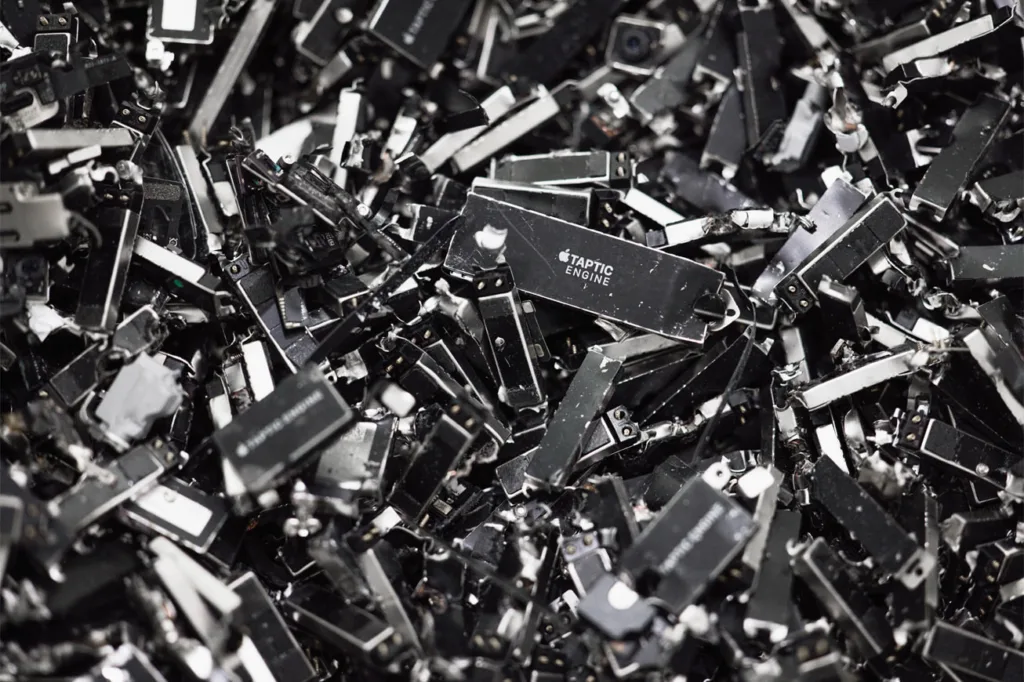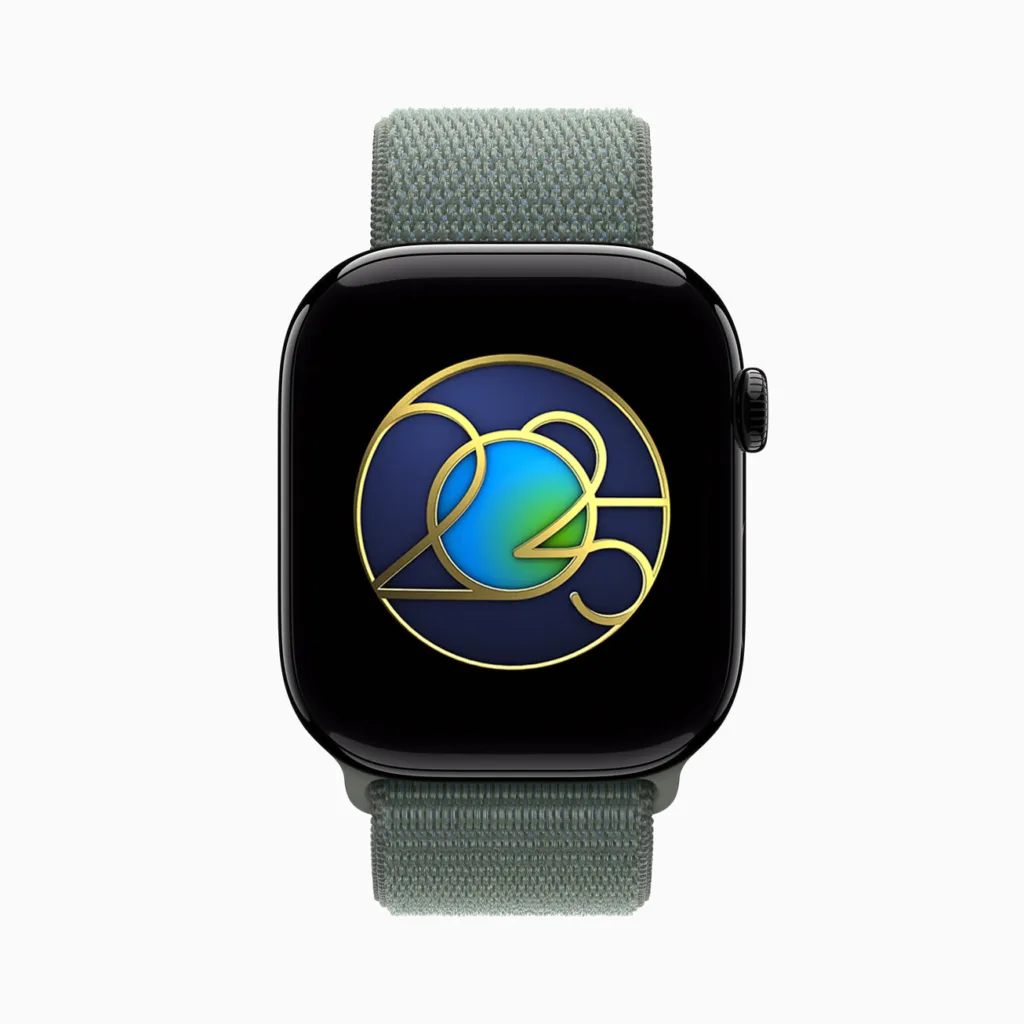This post was originally published on WBCSD
Ahead of Earth Day, Apple hits new milestones in emissions reductions, clean energy, and recycled materials.
Customers are invited to recycle devices in-store with a special offer through May 16.
Apple today announced that the company has surpassed a 60 percent reduction in its global greenhouse gas emissions compared to 2015 levels, as part of its Apple 2030 goal to become carbon neutral across its entire footprint in the next five years. The company achieved several other major environmental milestones, including the use of 99 percent recycled rare earth elements in all magnets and 99 percent recycled cobalt in all Apple-designed batteries.1 Apple shared this and other progress in its annual Environmental Progress Report, published today.
We’re incredibly proud of the progress we’re making toward Apple 2030, which touches every part of our business. Today, we’re using more clean energy and recycled materials to make our products than ever before, we’re preserving water and preventing waste around the world, and we’re investing big in nature. As we get closer to 2030, the work gets even harder — and we’re meeting the challenge with innovation, collaboration, and urgency.
– Lisa Jackson, Apple’s vice president of Environment, Policy, and Social Initiatives
Apple’s 2030 strategy prioritizes cutting greenhouse gas emissions by 75 percent compared with its 2015 baseline year, before applying high-quality carbon credits to balance the remaining emissions. Last year, Apple’s comprehensive efforts to reduce its carbon footprint — including the continued transition of its supply chain to renewable electricity and designing products with more recycled materials — avoided an estimated 41 million metric tons of greenhouse gas emissions.
As Apple celebrates Earth Day with its teams, partners, and customers around the world, including with a special offer for users who bring in devices for recycling, here’s a look at the progress the company is making across its environmental initiatives.
Accelerating Clean Energy in Apple’s Supply Chain
There are now 17.8 gigawatts of renewable electricity online in Apple’s global supply chain, thanks to the company’s long-standing collaboration with its suppliers to transition to 100 percent renewable energy for their Apple production by 2030. The renewable energy procured by Apple suppliers avoided 21.8 million metric tons of greenhouse gas emissions in 2024, an over 17 percent increase from the previous year. Additionally, suppliers avoided nearly 2 million metric tons of greenhouse gas emissions last year by working with Apple to optimize their energy efficiency.
Driving Cleaner Semiconductor Production
In addition to transitioning suppliers to clean energy, Apple is working across its supply chain to reduce the direct climate impact of industrial processes. This includes the manufacturing of semiconductors and flat-panel displays, both of which emit highly potent fluorinated greenhouse gases (F-GHGs). Today, Apple is announcing that 26 of its direct semiconductor suppliers have committed to abate at least 90 percent of F-GHGs from their facilities with Apple-related production by 2030. Many of these facilities also serve additional customers, helping this progress ripple beyond Apple. Additionally, 100 percent of the company’s direct display suppliers have made the same pledge. In 2024, display and semiconductor suppliers abated 8.4 million metric tons of greenhouse gas emissions, and the new commitments will accelerate that progress in the coming years.
Expanding the Use of Recycled and Renewable Materials
Apple continues to use more recycled and renewable materials across its products, helping drive down their carbon footprint without compromising quality or performance. Earlier this year, Apple surpassed 99 percent on the way toward its 2025 goals to use 100 percent recycled rare earth elements in all magnets and 100 percent recycled cobalt in all Apple-designed batteries. Magnets are by far the most significant use of rare earth elements in Apple products overall, and Apple-designed batteries comprise over 97 percent of Apple’s total cobalt use. Apple is committed to sourcing both recycled and primary minerals responsibly, and drives high human rights and environmental standards across its supply chain.

Eliminating Millions of Metric Tons of Waste
In 2024, suppliers participating in Apple’s Zero Waste program redirected approximately 600,000 metric tons of waste from landfills, bringing the total to 3.6 million metric tons since the program’s inception in 2015. That is equivalent to eliminating 4.5 million square meters of landfill space. Apple and its suppliers are innovating to further accelerate progress, from deploying recyclable protective films and reusable trays in manufacturing to recovering valuable metals from waste liquids generated during printed circuit board manufacturing.
Innovating to Reduce Product Emissions
Apple’s environmental progress continues to show up in its products. Earlier this year, the company introduced the new MacBook Air with over 55 percent recycled content overall, the most in any Apple product. Last year, Apple introduced its first-ever carbon neutral Mac with the new Mac mini. And customers can choose a carbon neutral option of any Apple Watch in any material. Apple’s carbon neutral products are the result of innovations to significantly reduce carbon emissions across their three biggest sources — materials, electricity, and transportation — before using high-quality carbon credits from nature-based projects to balance the small amount of remaining emissions.
Saving Billions of Gallons of Water Each Year
Apple and its suppliers have saved over 90 billion gallons of fresh water since launching the Supplier Clean Water Program in 2013, which promotes water reuse, efficiency, and other initiatives at facilities around the world. The average reuse rate by participating suppliers was 42 percent last year, saving 14 billion gallons of fresh water in 2024 alone. Across Apple’s corporate operations, the company has set a target to replenish 100 percent of freshwater withdrawals in high-stress locations by 2030. Apple has now initiated long-term partnerships amounting to over 40 percent of that target. This includes support for new and ongoing replenishment projects in the U.S., India, and Africa, which together are expected to deliver nearly 9 billion gallons in water benefits over the next 20 years.
Celebrating Earth Day with Apple
To celebrate Earth Day, Apple is offering customers and users a series of ways to learn and take action to protect the planet — from helping take part in recycling important materials, to enjoying content that celebrates Earth.
Through Apple Trade In and free recycling programs available at Apple Store locations around the world, customers can bring in the Apple products they no longer use for credit or to be responsibly recycled. From now until May 16, customers can receive 10 percent off an Apple accessory when they recycle an eligible item in-store. 2
On April 22, Apple Watch users can earn an Earth Day limited-edition award by completing any workout of 30 minutes or more, encouraging them to get outside and stay active. Apple Fitness+ offers thousands of workouts and meditations that can be done anytime, anywhere, including outside. On April 21, a new Time to Walk episode celebrating Earth Day will feature actress and climate advocate Shailene Woodley, and users can discover a collection of Time to Run episodes with Fitness+ trainers through Lake Tahoe; Zion National Park; Kona, Hawaii; and Yellowstone National Park, or enjoy an ocean breathing meditation with Fitness+ trainer Jessica Skye.
On the Apple TV app, customers can also enjoy movies and shows celebrating Earth in “The Future Is Up to Us,” a room that features family-friendly favorites, portraits of changemakers, and awe-inspiring Apple Originals like The Last of the Sea Women. And this Earth Day, Apple TV+ highlights the wonders of our planet through a slate of award-winning original series, specials, and shorts, including Jane, Stillwater, Earthsounds, Earth at Night in Color, Tiny World, Prehistoric Planet, The Secret Lives of Animals, Here We Are: Notes for Living on Planet Earth, and many more.

Through a new Earth Day collection in the Tips app, users can learn about planet-friendly actions available on iPhone, including how to identify plants in the Photos app, customize and download Maps for a journey outdoors, save electricity at home, and more.
For additional information about Apple’s environmental efforts, visit apple.com/environment.
This article first appeared on Apple’s website on 16 April 2025.
Footnotes
- Recycled materials are certified to standards that conform to ISO 14021, and all cobalt claims use mass balance allocation ↩︎
- Offer available to customers who recycle an eligible device and purchase a new eligible accessory in the same transaction between April 16, 2025, and May 16, 2025. Only at Apple Store locations. Additional restrictions apply. For full terms and conditions of the offer, visit apple.com/trade-in. ↩︎
The post Apple unveils environmental progress, surpassing 60 percent reduction in global greenhouse gas emissions first appeared on WBCSD.












0 Comments